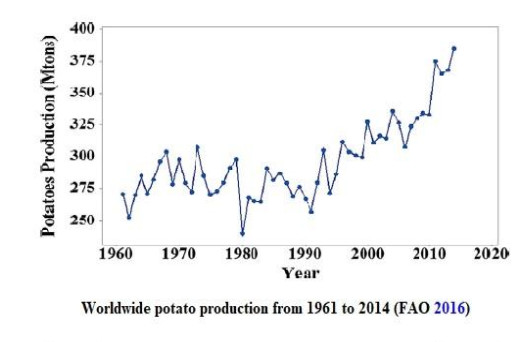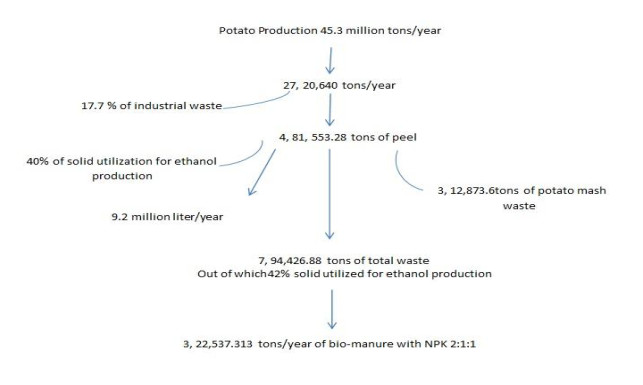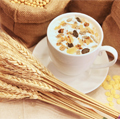| 1.
|
Emanuela Calcio Gaudino, Alessandro Colletti, Giorgio Grillo, Silvia Tabasso, Giancarlo Cravotto,
Emerging Processing Technologies for the Recovery of Valuable Bioactive Compounds from Potato Peels,
2020,
9,
2304-8158,
1598,
10.3390/foods9111598
|
|
| 2.
|
Jiří Souček, Algirdas Jasinskas,
Assessment of the Use of Potatoes as a Binder in Flax Heating Pellets,
2020,
12,
2071-1050,
10481,
10.3390/su122410481
|
|
| 3.
|
Shehzad Hussain, Ivi Jõudu, Rajeev Bhat,
Dietary Fiber from Underutilized Plant Resources—A Positive Approach for Valorization of Fruit and Vegetable Wastes,
2020,
12,
2071-1050,
5401,
10.3390/su12135401
|
|
| 4.
|
Yassmine Moemen El‐Gindy, Salma Hashem Abu Hafsa, Waleed Mostafa Dosoky,
Effects of potato peel extract on semen quality, sex hormones and immunity of rabbit bucks under intensive breeding system,
2020,
52,
0303-4569,
10.1111/and.13869
|
|
| 5.
|
Mateus Torres Nazari, César Vinicius Toniciolli Rigueto, Alan Rempel, Luciane Maria Colla,
Harvesting of Spirulina platensis using an eco-friendly fungal bioflocculant produced from agro-industrial by-products,
2021,
322,
09608524,
124525,
10.1016/j.biortech.2020.124525
|
|
| 6.
|
Jose S. Martinez-Fernandez, Xiangyu Gu, Shulin Chen,
Techno-economic assessment of bioactive compound recovery from potato peels with sequential hydrothermal extraction,
2021,
282,
09596526,
124356,
10.1016/j.jclepro.2020.124356
|
|
| 7.
|
Mona Ghorbani, Behnaz Dahrazma, Seyed Fazlolah Saghravani, Ghazaleh Yousofizinsaz,
A comparative study on physicochemical properties of environmentally-friendly lightweight bricks having potato peel powder and sour orange leaf,
2021,
276,
09500618,
121937,
10.1016/j.conbuildmat.2020.121937
|
|
| 8.
|
Tebogo Mphatlalala Mokgehle, Ntakadzeni Madala, Wilson Mugera Gitari, Nikita Tawanda Tavengwa,
Advances in the development of biopolymeric adsorbents for the extraction of metabolites from nutraceuticals with emphasis on Solanaceae and subsequent pharmacological applications,
2021,
01448617,
118049,
10.1016/j.carbpol.2021.118049
|
|
| 9.
|
Azmi Alvian Gabriel, Anggita Fitri Solikhah, Alifia Yuanika Rahmawati,
Tensile Strength and Elongation Testing for Starch-Based Bioplastics using Melt Intercalation Method: A Review,
2021,
1858,
1742-6588,
012028,
10.1088/1742-6596/1858/1/012028
|
|
| 10.
|
Lovepreet Singh, Sukhpreet Kaur, Poonam Aggarwal,
Enhanced functional and textural properties of waffle premix by addition of phytonutrient-rich industrial potato waste,
2022,
2190-6815,
10.1007/s13399-022-03246-x
|
|
| 11.
|
Donya Moradi, Yousef Ramezan, Soheyl Eskandari, Hossein Mirsaeedghazi, Majid Javanmard Dakheli,
Plasma-treated LDPE film incorporated with onion and potato peel extract – A food packaging for shelf life extension on chicken thigh,
2023,
35,
22142894,
101012,
10.1016/j.fpsl.2022.101012
|
|
| 12.
|
Fatima Zohra Choumane, Fatiha Zaoui, Fatma Kandouci, Bouhana Maachou, Belkacem Benguella,
Valorization of potato peel residues to produce a bioflocculant to be used in the treatment of liquid effluents,
2021,
1204,
1757-8981,
012002,
10.1088/1757-899X/1204/1/012002
|
|
| 13.
|
Seong Hyuk Lee, Sunmin Lee, Sung-Mok Lee, Jaeho Cha, Hyun Sook Lee, Sung Gyun Kang,
Biohydrogen Production from Food Waste Using Glucose-Adapted Hyperthermophilic Archaeon,
2023,
1877-2641,
10.1007/s12649-023-02049-z
|
|
| 14.
|
Fatiha Brahmi, Inmaculada Mateos-Aparicio, Khokha Mouhoubi, Sara Guemouni, Tassadit Sahki, Farid Dahmoune, Ferroudja Belmehdi, Chafiaa Bessai, Khodir Madani, Lila Boulekbache-Makhlouf,
Kinetic Modeling of Convective and Microwave Drying of Potato Peels and Their Effects on Antioxidant Content and Capacity,
2023,
12,
2076-3921,
638,
10.3390/antiox12030638
|
|
| 15.
|
Abraham Osiris Martínez-Olivo, Alba Cecilia Durán-Castañeda, Francia Guadalupe López-Cárdenas, José de Jesús Rodríguez-Romero, Jorge Alberto Sánchez-Burgos, Sonia Guadalupe Sáyago-Ayerdi, Victor Manuel Zamora-Gasga,
2023,
9780323885102,
217,
10.1016/B978-0-323-88510-2.00005-1
|
|
| 16.
|
Nadezhda Golubkina, Liubov Skrypnik, Lidia Logvinenko, Vladimir Zayachkovsky, Anna Smirnova, Leonid Krivenkov, Valery Romanov, Viktor Kharchenko, Pavel Poluboyarinov, Agnieszka Sekara, Alessio Tallarita, Gianluca Caruso,
The ‘Edge Effect’ Phenomenon in Plants: Morphological, Biochemical and Mineral Characteristics of Border Tissues,
2023,
15,
1424-2818,
123,
10.3390/d15010123
|
|
| 17.
|
Heidi Schalchli, Emilio Hormazábal, Álvaro Astudillo, Gabriela Briceño, Olga Rubilar, María Cristina Diez, Vijai Gupta,
Bioconversion of potato solid waste into antifungals and biopigments using Streptomyces spp.,
2021,
16,
1932-6203,
e0252113,
10.1371/journal.pone.0252113
|
|
| 18.
|
Barbara Sawicka, Dominika Skiba, Piotr Barbaś,
2022,
Chapter 2,
978-3-030-98759-6,
19,
10.1007/978-3-030-98760-2_2
|
|
| 19.
|
Mahmoud Moustafa, M. A. Abu-Saied, Tarek H. Taha, Mohamed Elnouby, EA El Desouky, Saad Alamri, Sulaiman Alrumman, Ali Shati, Mohmed Al-Khatani, Huda Alghamdii, Rahmah Al-Qthanin, Ahmed Al-Emam,
New blends of acrylamide/chitosan and potato peel waste as improved water absorbing polymers for diaper applications,
2022,
30,
0967-3911,
096739112210775,
10.1177/09673911221077559
|
|
| 20.
|
A N Huda, A M Sumitro, N A Hanifah, R B Lana, S M Dja’far, R M Aprilia, A Sabarudin, H Soetanto,
Antiprotozoal properties of potato peels and linseed oil and their effect on in vitro gas production,
2022,
977,
1755-1307,
012128,
10.1088/1755-1315/977/1/012128
|
|
| 21.
|
Md. Rezwanul Islam, Qingyue Wang, Yue Guo, Weiqian Wang, Sumaya Sharmin, Christian Ebere Enyoh,
Physico-Chemical Characterization of Food Wastes for Potential Soil Application,
2023,
11,
2227-9717,
250,
10.3390/pr11010250
|
|
| 22.
|
Albert Linton Charles, Nomalungelo Motsa, Annur Ahadi Abdillah,
A Comprehensive Characterization of Biodegradable Edible Films Based on Potato Peel Starch Plasticized with Glycerol,
2022,
14,
2073-4360,
3462,
10.3390/polym14173462
|
|
| 23.
|
Hira Nadeem,
Influence of different Carbon and Nitrogen Sources on the Production of Single Cell Biomass from Potato Peels,
2022,
2959-0981,
16,
10.54393/fbt.v2i01.22
|
|
| 24.
|
Hira Nadeem,
Conversion of Potato Peels into Single Cell Protein,
2021,
2959-0981,
09,
10.54393/fbt.v1i02.26
|
|
| 25.
|
Lovepreet Singh, Sukhpreet Kaur, Poonam Aggarwal,
Techno and bio functional characterization of industrial potato waste for formulation of phytonutrients rich snack product,
2022,
49,
22124292,
101824,
10.1016/j.fbio.2022.101824
|
|
| 26.
|
Dekka Srenuja, Akalya Shanmugam, Vadakkepulppara Ramachandran Nair Sinija,
Novel zero waste tactics for commercial vegetables – recent advances,
2022,
18,
1556-3758,
633,
10.1515/ijfe-2022-0126
|
|
| 27.
|
Fakhreddine Ben Amara, Moetaz Bouzid, Mouna Sahnoun, Yosri Ben Nasr, Bassem Jaouadi, Samir Bejar, Sonia Jemli,
Valorization of Potato Peels Starch for Efficient β‐Cyclodextrin Production and Purification through an Eco‐Friendly Process,
2022,
74,
0038-9056,
2200037,
10.1002/star.202200037
|
|
| 28.
|
Renu Singh, Sapna Langyan, Seema Sangwan, Priyanka Gaur, Fatima Nazish Khan, Pranjal Yadava, Bharti Rohatgi, Manoj Shrivastava, Ashish Khandelwal, Sibananda Darjee, Pramod Kumar Sahu,
Optimization and production of alpha-amylase using Bacillus subtilis from apple peel: Comparison with alternate feedstock,
2022,
49,
22124292,
101978,
10.1016/j.fbio.2022.101978
|
|
| 29.
|
Omojola Awogbemi, Daramy Vandi Von Kallon, Adefemi O. Owoputi,
Biofuel Generation from Potato Peel Waste: Current State and Prospects,
2022,
7,
2313-4321,
23,
10.3390/recycling7020023
|
|
| 30.
|
Hira Nadeem,
Effect of pH and Different Fermentation Time Intervals on the Production of Single Cell Proteins (SCPs) from Potato Peels,
2023,
2709-2798,
17,
10.54393/pbmj.v6i02.848
|
|
| 31.
|
Maninder Kaur, Anjali Gautam, Harpreet Kaur,
Nutritional, techno‐functional, structural, and rheological properties of potato peel powder: A valuable biowaste being potential source of dietary fiber and antioxidants in cookie formulation,
2022,
46,
0145-8892,
10.1111/jfpp.17033
|
|
| 32.
|
Mohamed A. Salem, Hend E. Abo Mansour, Esraa M. Mosalam, Riham A. El-Shiekh, Shahira M. Ezzat, Ahmed Zayed,
Valorization of by-products Derived from Onions and Potato: Extraction Optimization, Metabolic Profile, Outstanding Bioactivities, and Industrial Applications,
2023,
1877-2641,
10.1007/s12649-022-02027-x
|
|
| 33.
|
Helena Raclavská, Jana Růžičková, Barbora Švédová, Marek Kucbel, Michal Šafář, Konstantin Raclavský, Elton Luis Da Silva Abel,
2022,
9781119679844,
69,
10.1002/9781119679523.ch5
|
|
| 34.
|
Mohamed S. Hasanin,
Simple, Economic, Ecofriendly Method to Extract Starch Nanoparticles from Potato Peel Waste for Biological Applications,
2021,
73,
0038-9056,
2100055,
10.1002/star.202100055
|
|
| 35.
|
Naveed Qasim Abro, Najma Memon, Bakhtiar Ali Samejo, Masood Rehman Halepoto, Ayaz Ali Hakro,
Characterization and capacitive performance assessment of potato peels derived salt-induced porous carbons,
2022,
2190-6815,
10.1007/s13399-022-02579-x
|
|
| 36.
|
Fatiha Brahmi, Inmaculada Mateos-Aparicio, Alejandra Garcia-Alonso, Nadjet Abaci, Salima Saoudi, Leila Smail-Benazzouz, Hayate Guemghar-Haddadi, Khodir Madani, Lila Boulekbache-Makhlouf,
Optimization of Conventional Extraction Parameters for Recovering Phenolic Compounds from Potato (Solanum tuberosum L.) Peels and Their Application as an Antioxidant in Yogurt Formulation,
2022,
11,
2076-3921,
1401,
10.3390/antiox11071401
|
|
| 37.
|
Hawnaz Najmalddin, Seyhun Yurdugül, Haider Hamzah,
Screening of enzyme activities for improvement of bread quality by potato peel addition to the yeast growth medium,
2023,
51,
22124292,
102239,
10.1016/j.fbio.2022.102239
|
|
| 38.
|
Neha Chandra, Nirupama Mallick,
A synergistic “waste-to-wealth” approach towards a cyanobacterial biorefinery via valorizing potato peels for the cultivation of marine Synechococcus elongatus,
2022,
2190-6815,
10.1007/s13399-022-03281-8
|
|
| 39.
|
Sapna Birania, Sunil Kumar, Nitin Kumar, Arun Kumar Attkan, Anil Panghal, Priyanka Rohilla, Ravi Kumar,
Advances in development of biodegradable food packaging material from agricultural andagro‐industrywaste,
2022,
45,
0145-8876,
10.1111/jfpe.13930
|
|
| 40.
|
Marta Oleszek, Iwona Kowalska, Terenzio Bertuzzi, Wiesław Oleszek,
Phytochemicals Derived from Agricultural Residues and Their Valuable Properties and Applications,
2023,
28,
1420-3049,
342,
10.3390/molecules28010342
|
|
| 41.
|
R. H. Tlay, S. J. Abdul-Abbas, A.А. А. El-Maksoud, A. B. Altemimi, T. G. Abedelmaksoud,
Functional biscuits enriched with potato peel powder: Physical, chemical, rheological, and antioxidants properties,
2023,
6,
2618-7272,
53,
10.21323/2618-9771-2023-6-1-53-63
|
|
| 42.
|
Sofia Plakantonaki, Ioannis Roussis, Dimitrios Bilalis, Georgios Priniotakis,
Dietary Fiber from Plant-Based Food Wastes: A Comprehensive Approach to Cereal, Fruit, and Vegetable Waste Valorization,
2023,
11,
2227-9717,
1580,
10.3390/pr11051580
|
|
| 43.
|
Urvashi P. Mall, Vinayak H. Patel,
Effect of in vitro Digestion on the Bioaccessibility of Polyphenols and Potential Prebiotic Properties of Potato Peel,
2024,
15,
2772574X,
228,
10.2174/012772574X287665240118053142
|
|
| 44.
|
Deepti Jaswal, Keshani Bhushan, Gurvinder Singh Kocher, Arashdeep Singh,
Optimization of pretreatment of potato waste for release of fermentable sugars for vodka production: response surface methodology approach,
2024,
2190-6815,
10.1007/s13399-024-05698-9
|
|
| 45.
|
Inna Popova, Dev Shrestha, Matthew Morra,
Pilot-scale extraction of multiple biopesticidal compounds from mustard biofuel by-products,
2023,
199,
09266690,
116775,
10.1016/j.indcrop.2023.116775
|
|
| 46.
|
Nonsikelelo Sheron Mpofu, Josphat Igadwa Mwasiagi, Cleophas Achisa Mecha, Eric Oyondi Nganyi,
Evaluation of solanum tuberosum potato peel waste for use as an eco-friendly antibacterial finish for cotton fabrics,
2023,
1560-6074,
10.1108/RJTA-05-2023-0052
|
|
| 47.
|
Shuchi Upadhyay, Rajeev Tiwari, Sanjay Kumar, Shradhha Manish Gupta, Vinod Kumar, Indra Rautela, Deepika Kohli, Bhupendra S. Rawat, Ravinder Kaushik,
Utilization of Food Waste for the Development of Composite Bread,
2023,
15,
2071-1050,
13079,
10.3390/su151713079
|
|
| 48.
|
J. Echave, M. Fraga-Corral, A.G. Pereira, A. Soria-Lopez, M. Barral, F. Chamorro, Hui Cao, Jianbo Xiao, J. Simal-Gandara, M.A. Prieto,
2023,
9780323908856,
183,
10.1016/B978-0-323-90885-6.00004-1
|
|
| 49.
|
Diana Lucinda Castillo-Patiño, Humberto Geovani Rosas-Mejía, Alonso Albalate-Ramírez, Pasiano Rivas-García, Amanda Carrillo-Castillo, José Rubén Morones-Ramírez,
Transforming Agro-Industrial Waste into Bioplastic Coating Films,
2024,
9,
2470-1343,
42970,
10.1021/acsomega.4c05924
|
|
| 50.
|
Joseph Jegan Roy, Ernest Jun Jie Tang, Bin Cao, Madhavi Srinivasan,
Metal Extraction from Commercial Black Mass of Spent Lithium-Ion Batteries Using Food-Waste-Derived Lixiviants through a Biological Process,
2024,
12,
2168-0485,
16564,
10.1021/acssuschemeng.4c04317
|
|
| 51.
|
Sandeep Bose, Devendra Pal, Parisa A. Ariya,
On the Role of Starchy Grains in Ice Nucleation Processes,
2024,
4,
2692-1944,
1039,
10.1021/acsfoodscitech.3c00561
|
|
| 52.
|
Wenxiang Zhai, Yijing Zhong, Min Xu, Xinli Wei, Liping Cai, Changlei Xia, Yunzhao Wei,
An Antioxidant, Reusable Laser Printed and Recycled Cork Paper Packaging,
2024,
34,
1616-301X,
10.1002/adfm.202401820
|
|
| 53.
|
Manikant Tripathi, Rajeev Singh, Basant Lal, Akbar Mohammad, Irfan Ahmad, Akhilesh Kumar Yadav, Chang-Hyung Choi,
Fungal co-culture enabled co-fermentation of food waste for production of endoglucanase enzyme,
2024,
188,
09575820,
687,
10.1016/j.psep.2024.05.119
|
|
| 54.
|
Ovidiu Tiţa, Maria Adelina Constantinescu, Mihaela Adriana Tiţa, Cristina Bătuşaru, Ion Mironescu,
Sensory, textural, physico-chemical and enzymatic characterization of melted cheese with added potato and carrot peels,
2024,
10,
2296-861X,
10.3389/fnut.2023.1260076
|
|
| 55.
|
Fatima Bibi, Noshin Ilyas, Maimona Saeed, Sumera Shabir, Ali A. Shati, Mohammad Y. Alfaifi, Kassian T.T. Amesho, Subrata Chowdhury, Riyazali Zafarali Sayyed,
Innovative production of value-added products using agro-industrial wastes via solid-state fermentation,
2023,
30,
1614-7499,
125197,
10.1007/s11356-023-28765-6
|
|
| 56.
|
Milan Kumar Lal, Rahul Kumar Tiwari, Awadhesh Kumar, Ravinder Kumar, Dharmendra Kumar, Arvind Jaiswal, Sushil Sudhakar Changan, Som Dutt, Jelena Popović-Djordjević, Brajesh Singh, Jesus Simal-Gandara,
Methodological Breakdown of Potato Peel’s Influence on Starch Digestibility, In Vitro Glycemic Response and Pasting Properties of Potato,
2024,
101,
1099-209X,
65,
10.1007/s12230-024-09942-w
|
|
| 57.
|
Zhipeng Hu, Xianglu Zhu, Gaoya Dong, Joncer Naibaho, Shay Hannon, Da-Wen Sun, Brijesh K. Tiwari,
Valorization of potato by-products as a source of plant proteins: novel extraction techniques and potential applications,
2024,
1040-8398,
1,
10.1080/10408398.2024.2419534
|
|
| 58.
|
Anamika Chauhan, Fakhar Islam, Ali Imran, Ali Ikram, Tahir Zahoor, Sadaf Khurshid, Mohd Asif Shah,
A review on waste valorization, biotechnological utilization, and management of potato,
2023,
11,
2048-7177,
5773,
10.1002/fsn3.3546
|
|
| 59.
|
Gülsüm Ebru Ozer Uyar, Basar Uyar,
Potato peel waste fermentation by Rhizopus oryzae to produce lactic acid and ethanol,
2023,
11,
2048-7177,
5908,
10.1002/fsn3.3670
|
|
| 60.
|
Omojola Awogbemi, Daramy VandiVon Kallon,
2024,
Chapter 4,
978-981-99-8265-3,
65,
10.1007/978-981-99-8266-0_4
|
|
| 61.
|
Diana Jimenez-Champi, Frank L. Romero-Orejon, Angie Moran-Reyes, Ana María Muñoz, Fernando Ramos-Escudero,
Bioactive compounds in potato peels, extraction methods, and their applications in the food industry: a review,
2023,
21,
1947-6337,
418,
10.1080/19476337.2023.2213746
|
|
| 62.
|
Yashwanth Arcot, Minchen Mu, Thomas M. Taylor, Alejandro Castillo, Luis Cisneros-Zevallos, Mustafa E. S. Akbulut,
Essential Oil Vapors Assisted Plasma for Rapid, Enhanced Sanitization of Food-Associated Pathogenic Bacteria,
2024,
17,
1935-5130,
1507,
10.1007/s11947-023-03203-0
|
|
| 63.
|
Ying Zhou, Ye Tian, Baoru Yang,
Root vegetable side streams as sources of functional ingredients for food, nutraceutical and pharmaceutical applications: The current status and future prospects,
2023,
137,
09242244,
1,
10.1016/j.tifs.2023.05.006
|
|
| 64.
|
Nabia Ijaz, Shahid Bashir, Ali Ikram, Aimen Zafar, Huma Bader Ul Ain, Saadia Ambreen, Muhammad Ahmad, Riyadh S. Almalki, Muhammad Zubair Khalid, Waseem Khalid, Felix Kwashie Madilo,
Valorization of potato peel: a sustainable eco-friendly approach,
2024,
22,
1947-6337,
10.1080/19476337.2024.2306951
|
|
| 65.
|
Yogesh Gat, Anil Panghal, Narinder Kaur,
Isolation, Identification, and Process Optimization of Novel Strain Bacillus paramycoides from Food Waste,
2023,
19,
1550-9087,
138,
10.1089/ind.2023.0006
|
|
| 66.
|
Harsh Kumar, Shivani Guleria, Rajni Dhalaria, Richard Cimler, Vandana Guleria, Ruchi Sharma, Rajni Choudhary, Sivakumar Manickam, Kamil Kuča,
2024,
Chapter 3,
978-981-99-8265-3,
43,
10.1007/978-981-99-8266-0_3
|
|
| 67.
|
Astrid Santoso, Eri Amalia, Kartika Sari, Veni Takarini, Irna Sufiawati,
Histopathological Evaluation of Wound Healing and Anti-Inflammatory Effects of Granola Potato Peel Ethanol Extract in Rat Oral Mucosa,
2024,
Volume 16,
1179-1454,
377,
10.2147/JEP.S487373
|
|
| 68.
|
Bindu Naik, Vijay Kumar, Sheikh Rizwanuddin, Mansi Chauhan, Arun Kumar Gupta, Sarvesh Rustagi, Vivek Kumar, Sanjay Gupta,
Agro-industrial waste: a cost-effective and eco-friendly substrate to produce amylase,
2023,
5,
2661-8974,
10.1186/s43014-023-00143-2
|
|
| 69.
|
Jagadeesh Kumar Reddy Mutra, Satya Eswari Jujjavarapu, Nikita Verma,
Emergence of Plant-Based Decellularized Scaffolds for Tissue Regeneration: A Review,
2023,
11,
2168-0485,
6485,
10.1021/acssuschemeng.2c07445
|
|
| 70.
|
Sonali Khanal, Keikhosro Karimi, Sneha Majumdar, Vinod Kumar, Rachna Verma, Shashi Kant Bhatia, Kamil Kuca, Jesús Esteban, Dinesh Kumar,
Sustainable utilization and valorization of potato waste: state of the art, challenges, and perspectives,
2024,
14,
2190-6815,
23335,
10.1007/s13399-023-04521-1
|
|
| 71.
|
Ejigayehu Teshome, Tilahun A. Teka, Markos Makiso Urugo, Ruchira Nandasiri, Habtamu Fekadu Gemede, Indu Rani, Janet Adeyinka Adebo, Difo Voukang Harouna, Tessema Astatkie,
Extraction methods, industrial uses, and nutritional benefits of vegetable byproducts,
2024,
30,
1931-5260,
334,
10.1080/19315260.2024.2369892
|
|
| 72.
|
Yingdan Zhu, Yueting Luan, Yingnan Zhao, Jiali Liu, Zhangqun Duan, Roger Ruan,
Current Technologies and Uses for Fruit and Vegetable Wastes in a Sustainable System: A Review,
2023,
12,
2304-8158,
1949,
10.3390/foods12101949
|
|
| 73.
|
Ayman Ragab, Nasser Zouli, Ahmed Abutaleb, Ibrahim M. Maafa, M. M. Ahmed, Ayman Yousef,
Environmental and Economic Benefits of Using Pomegranate Peel Waste for Insulation Bricks,
2023,
16,
1996-1944,
5372,
10.3390/ma16155372
|
|
| 74.
|
GG Kavitha Shree, S. Arokiamary, M Kamaraj, J Aravind,
Biorefinery approaches for converting fruit and vegetable waste into sustainable products,
2024,
1735-1472,
10.1007/s13762-024-06202-6
|
|
| 75.
|
Mausumi Sarma, Sourav Chakraborty, Radhakrishnan Kesavan, Kshirod Kumar Dash, Prakash Kumar Nayak,
Starch‐Based Biodegradable Film from Fruit and Vegetable Waste and Its Standardization Modules Based on Neural Networks and Response Surface Methodology,
2024,
76,
0038-9056,
10.1002/star.202300082
|
|
| 76.
|
Daniel Nicolas Quintana Mariño, Diana P. Sanabria Chaparro, Hugo Felipe Salazar, Hugo Fernando Castro Silva, Ricardo Alfonso Paredes Roa,
Effect of Glycerin and Urea on the Synthesis of Potato and Cassava Starch-Based Biopolymers: Hardness, Micrography, and Thermogravimetric Analyses,
2025,
44,
2248-8723,
e109002,
10.15446/ing.investig.109002
|
|
| 77.
|
Olayinka J. Olaniyan, Enock O. Dare, A. Kehinde Akinlabi, David D. Diaz, Fatai O. Oladoyinbo, Goke A. Adebayo, Temitope O. Alonge, Olamuyiwa O. Emmanuel, A. M. Mosaku,
Development, Purification and Structural Evaluation of β-CDs from Cassava Waste Using CGTase and Nanostructured Encapsulated Plant Mediated AuNPs via Sustainable and Environmentally Friendly Techniques,
2025,
1183,
1662-8985,
35,
10.4028/p-TiIdh1
|
|










 DownLoad:
DownLoad:




